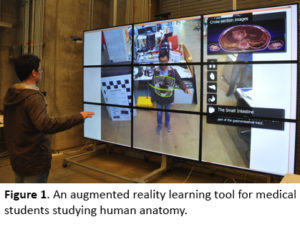 In this project, we will develop and refine a new interactive, augmented reality (AR) learning tool for anatomy education. The tool combines the Magic Mirror system and Balaur Display Wall to produce “in-situ” visualizations of medical information directly on top of the student’s own body. A gesture-based user interface (UI) allows the student to directly interact with medical illustrations.
In this project, we will develop and refine a new interactive, augmented reality (AR) learning tool for anatomy education. The tool combines the Magic Mirror system and Balaur Display Wall to produce “in-situ” visualizations of medical information directly on top of the student’s own body. A gesture-based user interface (UI) allows the student to directly interact with medical illustrations.
We will assess students' learning by examining changes in their anatomy knowledge over time using knowledge assessments and course grades. We will examine the usability of the tool (e.g., ease, functionality) by exploring full-body tracking data, system event logs (i.e., learners' interactions in the system), and time required to complete assigned tasks in the system relative to their learning outcomes. Multimodal machine learning methodologies will be applied to analyze the data.
This project will produce a new personalized educational tool for students learning human anatomy and will be the basis for future educational intervention work in this area. Moreover, this work has potential implications for the development of similar AR learning tools in other domains, such as rehabilitation exercise, and for other student populations (e.g., high school).
See the full story here: http://scienceoflearning.jhu.edu/research/can-augmented-reality-help-medical-students-learn-human-anatomy